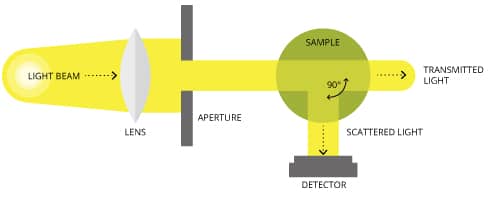Turbidity is one of the properties of water that allow us to characterize its quality. In drinking water, turbidity can serve as an indicator of harmful substances or organisms to natural ecosystems and human health. In industrial processes, solid particles in water can be detrimental to the end-use or the process downstream.
This said turbidity can serve as a quality control measure to assess the efficiency of the water treatment or the original quality of the water source.
As a general concept, water turbidity is an optical measurement of the relative clarity of a liquid. Turbid water appears hazy, murky, cloudy, or colored, as shown by the left side of Figure 1, as opposed to the right side where the water looks clear.

Water turbidity is caused by the presence of very tiny particles of clay, silt, inorganic and organic matter, algae, plankton, and other microscopic organisms in the water like shown in Figure 2. Yet, the concept also embraces fluorescent dissolved organic matter (FDOM) and colored dissolved organic matter (CDOM), like that tea-colored stain produced by decayed plants and leaves underwater [2].

Water turbidity increases as does the amount of solid matter in the water column. As consequence, water clarity is reduced to the point that if a light beam is passed through, the light will be scattered and absorbed by solid matter present in the water[2], [3]. This way, the more particles are contained, the more turbid the water would be.
Nonetheless, turbidity is not a direct or exact measure of the total suspended solids in water, but instead a measure of relative water clarity [2].
The dispersion effect that solid matter in water has over the light beam that passes through, allows measuring water turbidity as a function of how much light is scattered. This technique is called Nephelometry, and it is one of the most commonly utilized to measure water turbidity.
Nephelometry measures the amount of light that bounces off the suspended particles at a 90º angle from the transmitted light. A photodetector measures the scattered light an determines the turbidity of water [2] expressed in Nephelometric Turbidity Units (NTU). The method is shown in Figure 2.

Turbidity Nephelometer
However, there are several other methods to measure this water property; they are shown in Table 1.

Turbidity in water consumption is often associated with low water quality. Consumers accustomed to drinking high-quality clear water, would consider turbid water as being undrinkable or unsafe to drink. For this reason, correlations between the number of present solids in water and turbidity have been established.
A turbidity reading below 5 NTU appears clear, whereas a value of 55 NTU will start to show certain cloudiness. Furthermore, a reading over 500 NTU will appear completely opaque, as shown in Figure 3.

Turbidity in water can have different origins, and it can be an indicator of the presence of hazardous chemical or microbial contaminants, as well as pollution events taking place at the water collection point, such as heavy rain, spills, or groundwater contamination [3]. An example can be seen in Figure 4, where turbidity is increased as a consequence of the direct increase of total suspended solids through runoff resulting from heavy rainfall.

This way, by measuring turbidity, the possible repercussions in water quality and human health can be prevented, but it can also lead to the correct water treatment downstream [3].
Table 2 shows a comparison between different sources of turbidity, the implications, and the adequate treatment and management given the diverse water conditions.

Turbidity, beyond possible implications in human health, can also affect the natural equilibrium of aquatic ecosystems. An increased amount of total suspended solids in water can limit visibility and feeding behaviors. Suspended solids can obstruct the natural movement and migrations of aquatic populations, while also limiting the sight and speed of fish to catch their prey. Additionally, fish that remain in water bodies with high turbidity levels can clog fish gills and lower organisms’ resistance to disease and parasites [2].
Also, water can get warmer as a consequence of an increasing concentration of suspended particles in the water body. This results in a lower amount of dissolved oxygen in water, directly affecting the ability of aquatic organisms to survive [4].
Also, pathogens such as bacteria and protozoa can attach to the suspended particles in water, aiding them in transportation and protecting them from the action of water disinfectants, affecting aquatic and human life when the sediments are not removed [2].
Our BOSAQ team is aware of the importance of providing high-quality and clear water, for which we rely on our advanced water treatment technology, based on membranes, to clean water and ensure a provision of safe water, free from hazardous chemicals and pathogens to meet your water needs.
[1] W. Moseley, ‘Let’s Clear the Waters’, Noble Research Institute. https://www.noble.org/news/publications/ag-news-and-views/2009/may/lets-clear-the-waters/ (accessed Sep. 28, 2020).
[2] ‘Turbidity, Total Suspended Solids & Water Clarity’, Environmental Measurement Systems. https://www.fondriest.com/environmental-measurements/parameters/water-quality/turbidity-total-suspended-solids-water-clarity/ (accessed Sep. 28, 2020).
[3] World Health Organization, ‘WATER QUALITY AND HEALTH - REVIEW OF TURBIDITY: Information for regulators and water suppliers’, 2017. Accessed: Sep. 28, 2020. [Online]. Available: https://www.who.int/water_sanitation_health/publications/turbidity-information-200217.pdf.
[4] ‘Turbidity’. https://www.lenntech.com/turbidity.htm#What%20are%20the%20consequences%20of%20high%20turbidity? (accessed Sep. 30, 2020).